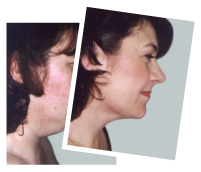Thread lifts are a less invasive procedure designed to address certain signs of ageing by providing a lifting effect to targeted areas of the face and neck. While less invasive than surgical options, thread lifts carry risks and potential side effects. Individual recovery times and outcomes may vary, and it is important to consult with a qualified healthcare professional to determine if this procedure is suitable for you.
Dr Gordon Ku has performed hundreds of these procedures and regularly trains other doctors in this procedure.
What is a Thread Lift?
Thread Lift is a non-surgical procedure that aims to address signs of ageing by the placement of biocompatible sutures under the skin to provide a subtle lifting effect. While a thread lift procedure is less invasive than some surgical procedures, it still carries certain risks and potential side effects.
What are the steps in a Silhouette Soft® Thread Lift Treatment?
Pre-treatment Consultation
During your consultation, your physician will evaluate your cosmetic concerns and review your medical history to ensure the procedure is appropriate.
Like all medical procedures, a thread lift carries certain risks. It’s important to fully disclose your medical history prior to treatment, as some conditions or medications could increase these risks. Some skin allergies and neurological conditions, or medications can jeopardise your safety or results.
During the Treatment
Before conducting the treatment your physician will evaluate your needs and explain where the sutures will be placed using a marking pen. The treated areas will be sterilised, and you may be given a topical anaesthetic to numb the area prior to the suture’s insertion.
The thread lift involves inserting sutures into the fat layer under the skin. Some people may experience a low level of discomfort during and after the procedure, but this can vary depending on the individual. Once the suture has been applied, the doctor performs slight moulding of the skin to reshape it by hand and to obtain the desired lifting effect. The non-inserted ends of the suture are cut off.
The number of sutures applied depends on the skin laxity and condition.
Following the Treatment
The insertion of thread sutures elicits a minimal inflammatory reaction, this is normal and required. After placement patients may experience some slight side effects, This may include minor pain, swelling and bruising.
Following the procedure, some patients may notice an immediate tightening effect. This is due to the bi-directional cones on the suture helping to hold the skin in a lifted position. Over time, the polylactic acid in the suture may stimulate the body’s collagen production. This can contribute to a gradual improvement in the contours of the face. However, results can vary and it’s important to have realistic expectations.
Your physician will provide you with post-treatment recommendations and an aftercare programe to follow to ensure the best possible result.
Frequently Asked Questions
What are the components of Thread Sutures?
Thread Suture monofilaments are made of Polylactic Acid (PLLA) while the cones are made of poly (L-lactide-co-glycolide) (PLGA). Polylactic Acid (PLLA) and poly (L-lactide-co-glycolide) (PLGA) are two types of biocompatible polymers that are often used in medical devices. While they are generally well-tolerated, individual reactions can vary.
Areas Commonly Treated
Thread lifts can be used to address specific areas of the face and neck, including:
- Jawline and jowls
- Cheeks and mid-face region
- Under-eye hollows
- Neck contours
Effectiveness may vary depending on individual characteristics and the treatment area.
Considerations and Contraindications
Potential Risks and Side Effects
Like all medical procedures, thread lifts carry potential risks. These may include:
- Infection
- Swelling, bruising, or pain
- Skin irregularities at insertion points
- Temporary inflammation
It is important to contact your healthcare provider if you experience any adverse effects.
What must be done before Thread Lift treatment?
While a thread lift treatment doesn’t typically require extensive preparation, it’s important to discuss your expectations and any questions you have with your doctor before starting treatment. You should also inform your doctor of any previous treatments you’ve received and any medications you’re currently taking.
What happens immediately after treatment?
Like all medical procedures, a thread lift can have side effects, which can include infection, inflammation, pain, swelling, bruising, and skin irregularities at the entry points. While these side effects often resolve within a few days, they can vary in severity and duration. If you experience any side effects, it’s important to consult with your doctor.
If you experience any side effects, you should talk to your doctor.
Are there any contraindications to Thread Lift treatment?
Patients with foreign body sensitivity or known or suspected allergies to implant or instrument materials, particularly plastic/biomaterial, should consult with their doctor before undergoing the procedure, as these conditions could increase the risk of complications. Do NOT use in patients with active sepsis or infection, active (or history of) autoimmune disease, patients under 18 years of age, pregnant or breastfeeding women, or patients with limited ability or un-willingness to follow post-treatment recommendations.
Is Thread Lift treatment painful?
The treatment is performed under local anaesthetic, which helps to manage pain during the procedure. However, some patients may still experience some discomfort.
Are there any recommendations to be followed after treatment?
After Sitreatment, there are several recommendations to help ensure a smooth recovery. These include avoiding touching the face or applying makeup for 24 hours, taking pain relief if needed, sleeping in an elevated position, and avoiding certain activities and treatments for specified periods. It’s important to note that recovery can vary between individuals.




